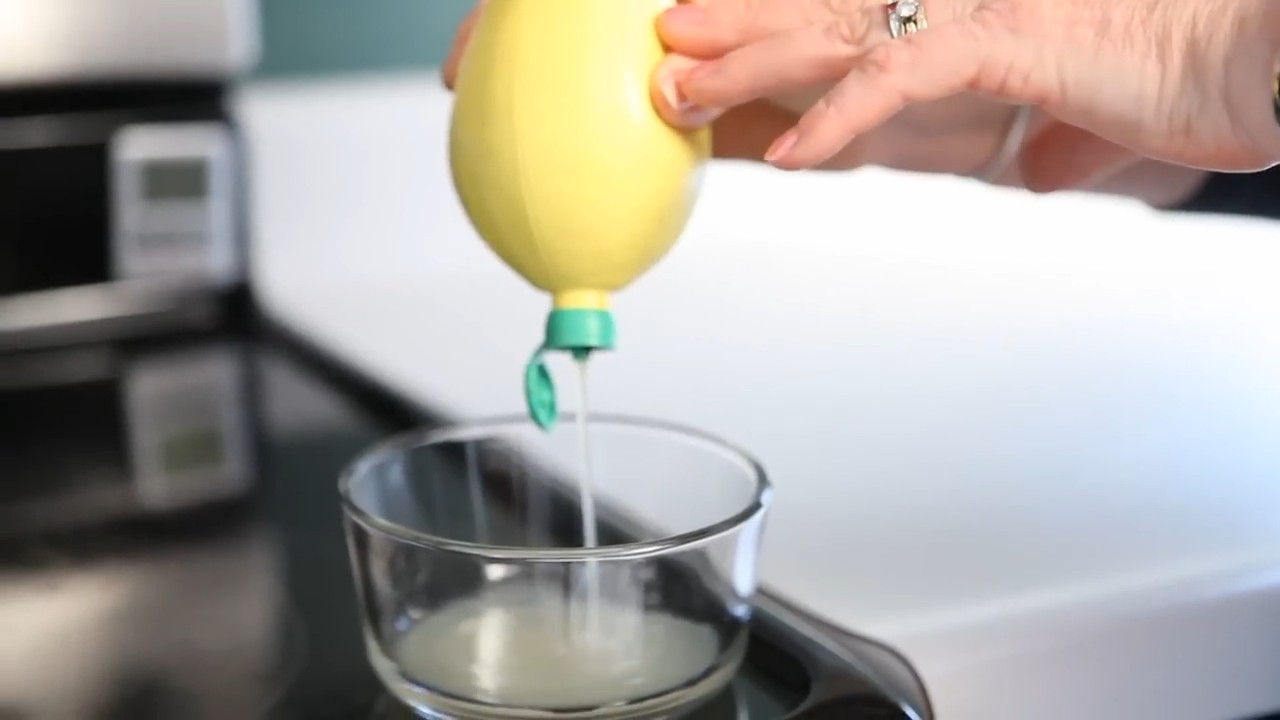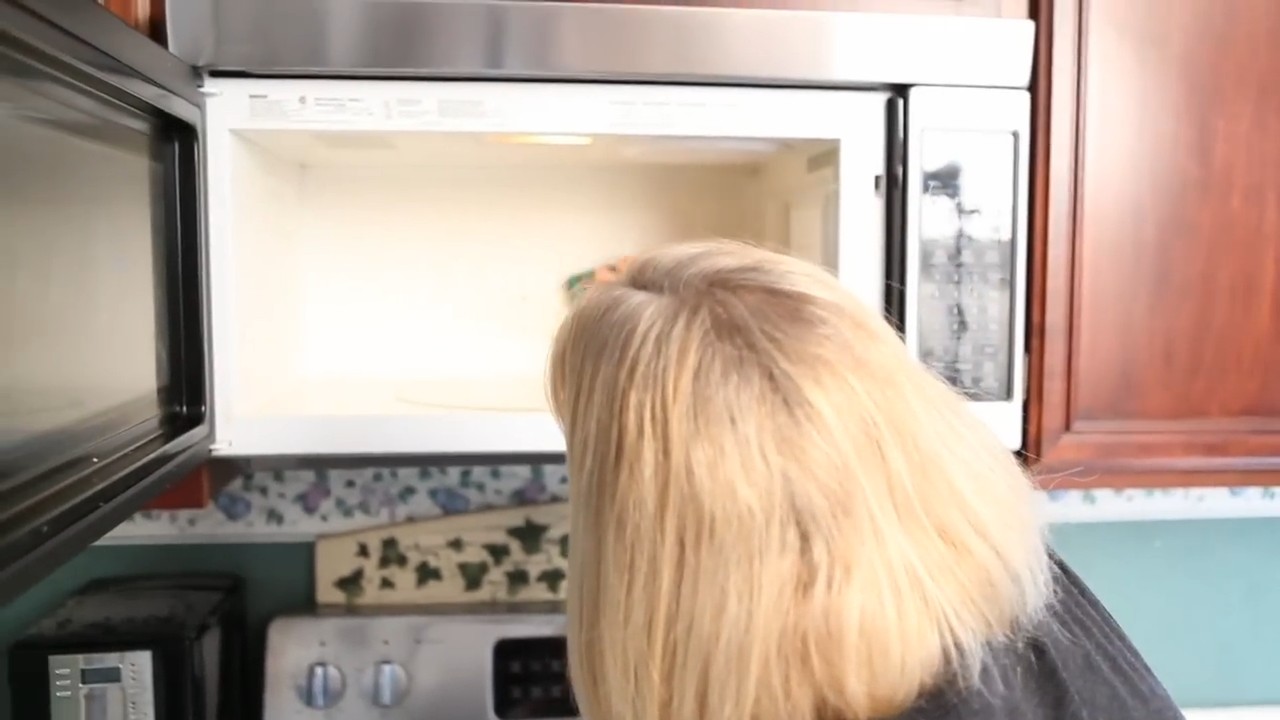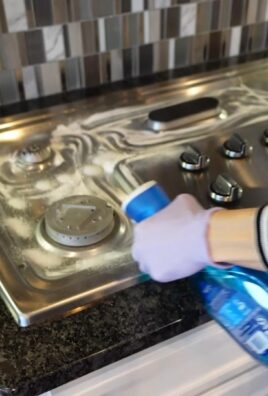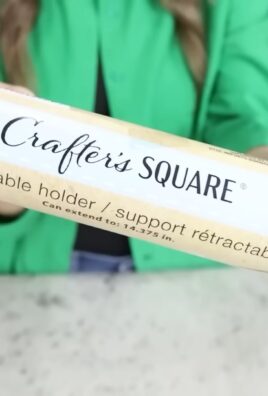Microwave cleaning with lemon steam – sounds like a spa treatment for your appliance, right? Well, it practically is! Let’s be honest, cleaning the microwave is one of those chores we all dread. Splattered sauces, forgotten leftovers, and mysterious food explosions leave it looking like a culinary crime scene. But fear not, fellow home cooks! I’m here to share a super easy, all-natural DIY trick that will have your microwave sparkling in minutes, without harsh chemicals or endless scrubbing.
Believe it or not, using steam to clean has been around for ages. Think of Roman bathhouses or even your grandma’s pressure cooker! Harnessing the power of steam is a time-tested method for loosening grime and making cleaning a breeze. And when you add the natural cleaning power of lemon, you’ve got a winning combination.
Why is this microwave cleaning with lemon steam trick so essential? Because nobody wants to spend hours scrubbing away baked-on food. Plus, many commercial microwave cleaners are full of harsh chemicals that you then heat up with your food – yikes! This DIY method is not only effective but also safe, eco-friendly, and smells amazing. So, ditch the elbow grease and embrace the power of lemon steam – your microwave (and your nose) will thank you!

DIY Microwave Cleaning with Lemon Steam: A Fresh and Easy Hack
Okay, let’s be honest, cleaning the microwave is probably nobody’s favorite chore. But it’s one of those things that, if left unattended, can quickly become a sticky, splattered mess. Luckily, I’ve got a super simple and effective hack that uses just one ingredient: a lemon! This method uses the power of lemon steam to loosen up all that grime, making it a breeze to wipe clean. Trust me, you’ll be amazed at how well it works and how fresh your microwave will smell afterward.
What You’ll Need
Before we dive in, let’s gather our supplies. This is a pretty minimal list, which is always a win in my book!
* A lemon (fresh is best!)
* A microwave-safe bowl
* Water
* A clean sponge or cloth
Step-by-Step Instructions
Alright, let’s get this microwave sparkling! Follow these steps, and you’ll have a clean microwave in no time.
1. Prepare the Lemon Water: First, grab your lemon and give it a good rinse. Then, cut it in half. Squeeze the juice from both halves into your microwave-safe bowl. Don’t throw away the lemon rinds just yet! We’ll be using those too.
2. Add the Rinds and Water: Now, place the lemon rinds into the bowl with the juice. Add about one cup of water to the bowl. You want enough water to create steam, but not so much that it overflows when it boils.
3. Microwave the Mixture: Place the bowl of lemon water into your microwave. Set the timer for 3 minutes on high. Keep a close eye on it. You want the water to boil and create steam. If it doesn’t seem to be boiling after 3 minutes, add another minute or two.
4. Let it Steam: This is the crucial part! Once the microwave stops, do not open the door immediately! Let the lemon steam work its magic for about 5 minutes. This allows the steam to loosen all the splatters and grime inside. The longer you let it sit, the easier the next step will be.
5. Carefully Remove the Bowl: After the 5 minutes are up, carefully remove the bowl from the microwave. Be cautious, as the bowl and water will be hot. Use oven mitts or a towel to protect your hands.
6. Wipe Down the Interior: Now for the satisfying part! Take your clean sponge or cloth and wipe down the interior of the microwave. You should find that the splatters and grime wipe away easily. If you encounter any stubborn spots, you can dip your sponge or cloth into the warm lemon water for extra cleaning power.
7. Clean the Turntable and Roller Ring: Don’t forget to remove the turntable and roller ring from the microwave. Wash them with warm, soapy water. Rinse them thoroughly and dry them before placing them back in the microwave.
8. Wipe Down the Exterior: Finally, give the exterior of your microwave a wipe down with a damp cloth. This will remove any fingerprints or smudges.
Troubleshooting and Tips
Sometimes, even with the best instructions, things don’t go exactly as planned. Here are a few troubleshooting tips and extra hints to help you get the best results.
* Stubborn Stains: If you have some really stubborn stains that aren’t coming off easily, try making a paste of baking soda and water. Apply the paste to the stain, let it sit for a few minutes, and then wipe it away. The baking soda acts as a gentle abrasive to help lift the stain.
* Lemon Alternatives: While lemon is my go-to for this hack, you can also use vinegar. Mix equal parts water and white vinegar in the microwave-safe bowl and follow the same steaming process. Vinegar works well, but it does have a stronger odor than lemon.
* Preventative Measures: To keep your microwave cleaner for longer, try covering your food with a microwave-safe lid or plastic wrap when you’re heating it up. This will help prevent splatters. Also, try to wipe up any spills as soon as they happen.
* Smelly Microwave: If your microwave has a lingering odor, the lemon steam method can help to neutralize it. You can also try placing an open box of baking soda in the microwave to absorb odors.
* Microwave-Safe Bowl: Make sure the bowl you are using is actually microwave-safe. Some plastics can melt or warp in the microwave. Glass or ceramic bowls are usually the safest options.
* Steam Time: Adjust the steaming time based on how dirty your microwave is. If it’s really grimy, you might need to steam it for a bit longer.
* Safety First: Always be careful when handling hot bowls and water. Use oven mitts or a towel to protect your hands. And never leave the microwave unattended while it’s running.
Why This Hack Works
You might be wondering why this simple lemon steam method is so effective. Here’s the science behind it:
* Steam: The steam helps to loosen the dried-on food particles and splatters that are stuck to the inside of the microwave. It essentially softens the grime, making it easier to wipe away.
* Lemon Juice: Lemon juice is a natural cleaning agent. It contains citric acid, which helps to break down grease and grime. It also has antibacterial properties, which can help to kill germs.
* Lemon Scent: The lemon scent is a bonus! It leaves your microwave smelling fresh and clean.
Maintaining a Clean Microwave
Once you’ve got your microwave sparkling clean, you’ll want to keep it that way! Here are a few tips for maintaining a clean microwave:
* Wipe Up Spills Immediately: The easiest way to keep your microwave clean is to wipe up any spills as soon as they happen. This prevents the spills from drying and becoming harder to remove.
* Cover Food When Heating: Use a microwave-safe lid or plastic wrap to cover your food when you’re heating it up. This will help to prevent splatters.
* Regular Cleaning: Aim to clean your microwave at least once a week. This will prevent grime from building up and make cleaning easier in the long run.
* Use Microwave-Safe Containers: Only use containers that are specifically labeled as microwave-safe. This will prevent them from melting or releasing harmful chemicals into your food.
* Avoid Overheating: Overheating food can cause it to splatter and make a mess. Try to heat your food in shorter intervals, stirring in between, to prevent overheating.
Beyond the Lemon: Other Natural Cleaning Options
While I love the lemon steam method, there are other natural cleaning options you can use for your microwave. Here are a few ideas:
* Vinegar: As mentioned earlier, vinegar is a great alternative to lemon. It’s a powerful cleaning agent and can help to remove grease and grime.
* Baking Soda: Baking soda is a gentle abrasive that can be used to scrub away stubborn stains. You can make a paste of baking soda and water and apply it to the stains.
* Orange Peels: Similar to lemons, orange peels contain citric acid and can be used to clean and deodorize your microwave. Follow the same steaming process as with lemons.
* Essential Oils: Add a few drops of your favorite essential oil to the water when you’re steaming your microwave. This will leave it smelling even fresher. Lemon, lavender, and tea tree oil are all good options.
The Joy of a Clean Microwave
There’s something incredibly satisfying about having a clean microwave. It’s one of those small things that can make a big difference in your kitchen. Plus, knowing that you’re using a natural and non-toxic cleaning method is always a good feeling. So, give this lemon steam hack a try, and I promise you’ll be amazed at the results! Happy cleaning!

Conclusion
So, there you have it! This simple, yet incredibly effective, microwave cleaning with lemon steam trick is a game-changer for anyone who wants a sparkling clean microwave without harsh chemicals or endless scrubbing. It’s a must-try for busy individuals, eco-conscious families, and anyone who appreciates a fresh, citrusy scent wafting through their kitchen.
Why is this method a must-try? Because it tackles the baked-on food splatters and grime that plague every microwave with minimal effort. The lemon steam acts as a natural degreaser, loosening the stubborn messes so they wipe away with ease. Forget spending hours scrubbing with abrasive cleaners that can damage your microwave’s interior. This method is gentle, effective, and leaves your microwave smelling fantastic.
But the beauty of this DIY trick lies in its versatility. While lemon is the star of the show, feel free to experiment with other citrus fruits. Lime or orange slices work just as well, each imparting its unique aroma. For an extra boost of cleaning power, add a tablespoon of white vinegar to the water. Vinegar is a natural disinfectant and helps to further break down grease and grime. You can also add a few drops of your favorite essential oil, like lavender or eucalyptus, for an even more personalized scent. Just be sure to use essential oils that are safe for microwave use and avoid anything flammable.
Don’t be afraid to adjust the steaming time based on the severity of the mess in your microwave. If you have particularly stubborn stains, try steaming for an extra minute or two. And remember to always use a microwave-safe bowl and handle it with care after heating, as it will be hot.
We are confident that once you try this microwave cleaning with lemon steam trick, you’ll never go back to your old cleaning methods. It’s quick, easy, affordable, and environmentally friendly. Plus, the refreshing lemon scent is a welcome bonus!
So, what are you waiting for? Grab a lemon, a microwave-safe bowl, and get ready to transform your microwave from a grimy mess to a sparkling clean appliance. We encourage you to try this DIY trick and share your experience with us in the comments below. Let us know what variations you tried and how well they worked. We can’t wait to hear your success stories! Share your before and after photos on social media and tag us – we’d love to see your sparkling clean microwaves!
Frequently Asked Questions (FAQ)
Q: Can I use bottled lemon juice instead of fresh lemons?
A: While fresh lemons are preferred for their natural oils and fragrance, you can use bottled lemon juice in a pinch. Use about 2-3 tablespoons of bottled lemon juice in the water. Keep in mind that the scent might not be as strong as with fresh lemons, but the cleaning power will still be effective. Fresh lemons contain natural oils that contribute to the degreasing and deodorizing properties of the steam, so if possible, opt for fresh.
Q: How long should I microwave the lemon water?
A: The recommended time is typically 3-5 minutes, or until the water boils vigorously and the microwave is filled with steam. However, the exact time may vary depending on the power of your microwave. Start with 3 minutes and check if the water is boiling and the microwave is steamy. If not, add another minute or two. Be careful not to overheat the water, as this could cause it to splatter.
Q: What if my microwave is really dirty? Will this trick still work?
A: Yes, this trick can still work on a very dirty microwave, but you might need to repeat the process or use a little extra elbow grease. After steaming, let the microwave sit for a few minutes to allow the steam to further loosen the grime. Then, wipe down the interior with a damp sponge or cloth. For stubborn spots, you may need to scrub gently with a non-abrasive sponge or a paste made of baking soda and water. If the microwave is extremely dirty, consider steaming it twice in a row for maximum effectiveness.
Q: Is it safe to use lemon juice in the microwave?
A: Yes, it is generally safe to use lemon juice in the microwave. Lemon juice is a natural and non-toxic cleaning agent. However, always use a microwave-safe bowl and handle it with care after heating, as it will be hot. Avoid using metal containers or utensils in the microwave. Also, be sure to wipe down the interior of the microwave thoroughly after cleaning to remove any residual lemon juice.
Q: Can I use other citrus fruits besides lemon?
A: Absolutely! Lime and orange slices are excellent alternatives to lemon. They offer similar cleaning properties and impart their own unique fragrances. Grapefruit can also be used, but its scent might be a bit stronger and less universally appealing. Experiment with different citrus fruits to find your favorite scent and cleaning power.
Q: What if I don’t have any citrus fruits? Is there another alternative?
A: If you don’t have any citrus fruits, you can use white vinegar as an alternative. Mix equal parts water and white vinegar in a microwave-safe bowl and microwave for the same amount of time as you would with lemon water. Vinegar is a powerful degreaser and disinfectant, but it does have a stronger odor than citrus fruits. You can add a few drops of essential oil to the vinegar water to help mask the smell.
Q: How often should I clean my microwave using this method?
A: The frequency of cleaning depends on how often you use your microwave and how messy it gets. As a general rule, it’s a good idea to clean your microwave at least once a week to prevent food splatters from building up and becoming difficult to remove. If you use your microwave frequently or tend to make messy meals, you may need to clean it more often.
Q: What kind of bowl should I use?
A: Always use a microwave-safe bowl made of glass, ceramic, or microwave-safe plastic. Avoid using metal bowls or containers, as they can cause sparks and damage your microwave. Make sure the bowl is large enough to hold the water and lemon slices without overflowing when boiling.
Q: The lemon scent lingers in my microwave after cleaning. How can I get rid of it?
A: The lemon scent should dissipate naturally within a few hours. If you find the scent too strong, you can leave the microwave door open for a while to allow it to air out. You can also place a small bowl of baking soda inside the microwave overnight to absorb any lingering odors.
Q: Can I use this method to clean the outside of my microwave too?
A: While this method is primarily designed for cleaning the interior of your microwave, you can use the lemon-infused water to wipe down the exterior as well. Dip a clean cloth or sponge into the water and wipe down the outside surfaces of the microwave. Be sure to dry the exterior thoroughly with a clean cloth.
Q: What if I accidentally microwave the bowl for too long and the water boils over?
A: If the water boils over, immediately turn off the microwave and allow it to cool down before opening the door. Use caution when removing the bowl, as it will be very hot. Clean up any spilled water with a damp cloth or sponge. In the future, be sure to monitor the microwave while it’s running and adjust the cooking time as needed to prevent boil-overs.





Leave a Comment